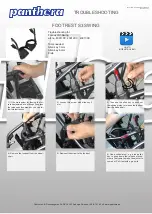
R Healthcare Technical Information Manual - Dash Page 49 March 2007 Revision B
Fitting Instruction
– Elevating Leg Rest, (ELR) right hand, left hand.
Part number
Various
Where used
Dash Lite
Tools and Techniques
No tools required;
Service and maintenance check
At each service check for:
Sharp Edges
Contamination
Footplate and calf pad damage
Assy fit for purpose
Damaged or worn, components need to be replaced, if assembled in pairs R Healthcare recommends replace both
assemblies, for continuity of wheelchair in use.
When these are fitted to a wheelchair, they provide support to the underside of the user’s calf, at a range of angular positions. They fit into the
standard footrest bracket swivel points at the front of the wheelchair, and can be released and swung away or removed during side transfer or other
manoeuvres in the same way as the standard type footrest.
R Healthcare recommends that because of possible finger trap areas, that an attendant locates releases or adjusts the leg rest
to required position as advised by assessor. Movement of Elevating Leg rests should be controlled from the outside of the chair
using both hands to steady the assembly during assembly or adjustment.
The calf support pad can be swivelle
d through 90 degrees for sideways folding of the wheelchair. Carer’s should ensure that the
locking latch is fully engaged the when refitting the Legrest or any similar adaptation prior to use. Angular calf support ad justment is
by means of a sprung release trigger, which locks along a fixing bar at any preferred position within the adjustment range.
Operation of this requires a degree of finger strength, and it is recommended that this is carried out by a carer or trained attendant.
Users and carer’s are reminded that when the Elevating Legrest is adjusted to a high position, the swing away action requires
greater space. The footplate is adjusted and secured using the same method as standard Dash Lite footrest.
When the E.L.R is adjusted to suit it’s most upright setting the assembly needs to be disconnected and removed from the main
body of the wheelchair for transfer of occupant, or in a transit situation.
Note that the fitting and position of the Elevating Legrest can alter the balance of the chair. This is particularly significant when the
Legrest is fully extended, and supporting a large heavy limb. In this position, weight distribution may be such that the whee lchair is
balanced towards the front wheels, with the rear wheels taking only a nominal weight. This affects general chair control and also
effectiveness of brakes.
Cleaning Method
Wipe clean and dried using warm soapy water and cloth.
Use Assessment & Training
To be provided for use after assessment by clinically qualified therapist, healthcare professional or rehabilitation engineer
When weight is on the front wheels, control of the wheelchair in an outdoor environment particularly when going downhill,
can become impossible, and this should always be avoided. Adverse weather conditions must be avoided, such as wet
leafy weather, because control of the wheelchair will be very difficult, putting the occupant into a potentially harmful
position.
Spares and Options should only be fitted by a trained and competent person
Post code S41 8NJ
Weight excluding packaging 2.2Kg:




































